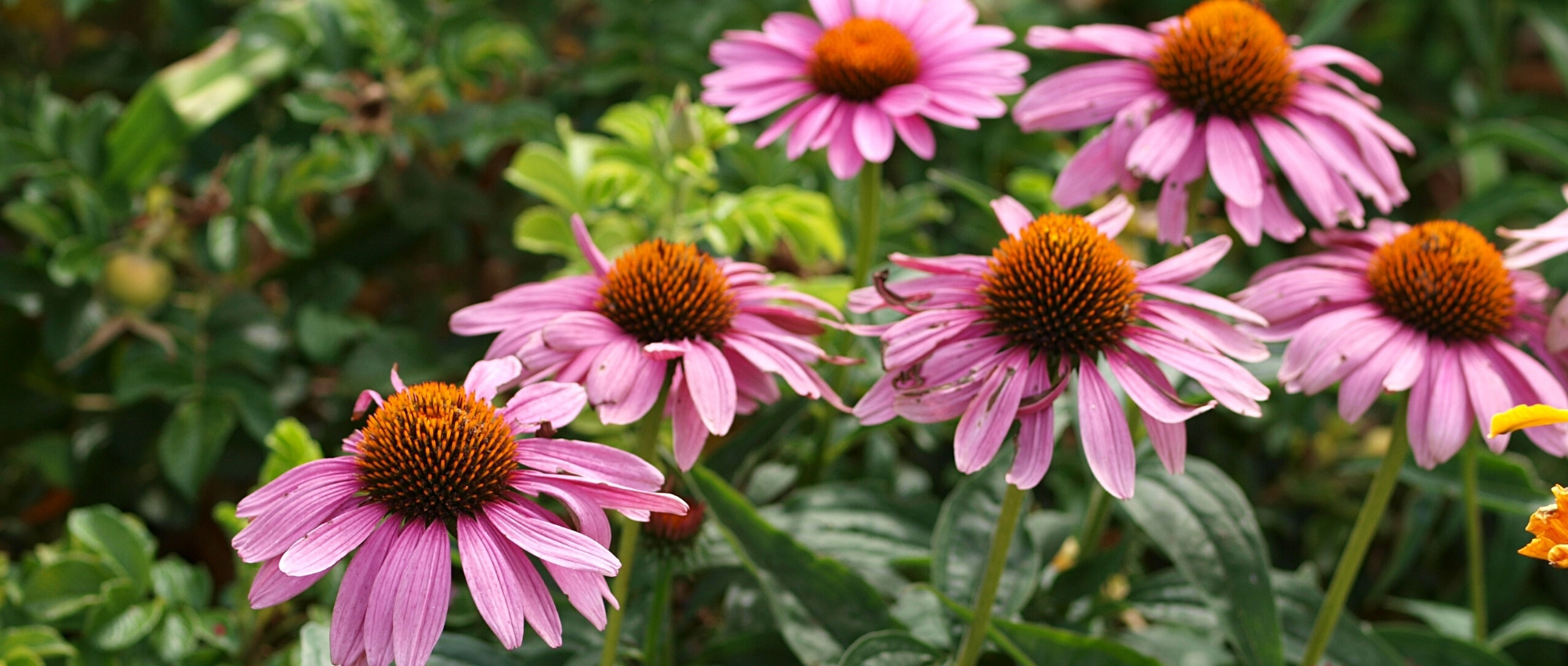
10 perennial plants for late summer flowering
For a flowering garden in August - September
Contents
Many perennials bloom in summer, but some of them stand out for their later flowering, ensuring a smooth transition into autumn. This includes, for example, Japanese anemones, asters, eupatoriums, and echinaceas… Most of these plants bloom in August-September. However, their flowering period also depends on the weather and the region where you live (in northern France or in the mountains, flowering will occur later than in the Mediterranean basin)! Feel free to combine these perennials to create stunning colourful borders in late summer to early autumn.
Japanese Anemones
Japanese Anemones are stunning perennials for partial shade. They offer, typically between August and October, beautiful flowers with soft pink or white petals, sometimes purplish, surrounding yellow stamens. Their flowering is very simple and poetic! It is undoubtedly one of the most beautiful flowers of late summer. There are many varieties: some have white flowers, others are pink, and there are also dwarf varieties that do not exceed 40 cm in height, while others are much taller, reaching up to 1.5 m! For example, discover the variety ‘Honorine Jobert’, a large and highly floriferous Japanese anemone that produces beautiful pure white flowers.
Japanese anemones prefer cool, humus-bearing soils, without excessive lime. Place them in a sheltered spot from the scorching sun, ideally in partial shade, protected by a tree or a hedge. They are perfect companions for ferns, hostas, asters, and echinaceas.
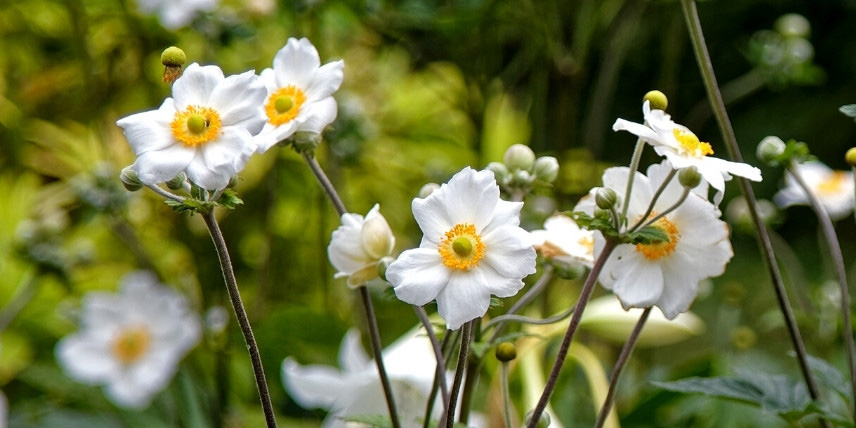
Japanese anemone ‘Honorine Jobert’ (photo Acabashi)
→ Learn more with our complete guide on Japanese Anemones
Asters
Asters brighten the end of summer and the beginning of autumn with their countless small flowers, shaped like daisies. They consist of numerous white, blue, mauve, or pink petals (ligulate flowers) surrounding a centre of small yellow tubular flowers. There are dwarf varieties with a prostrate habit, as well as much taller and upright ones. To enjoy flowering during this period, you can choose Asters novi-belgii, Aster novae-angliae, Aster ageratoides, Aster dumosus, or Aster amellus. However, avoid Asters alpinus, which flower in spring, and Asters sibiricus, which bloom in summer.
Their airy flowering is appreciated, bringing lightness and volume to borders. Additionally, asters have a rather natural style and integrate very well into cottage gardens. It is best to plant them in full sun, in well-draining soil that remains cool in summer.
For flowering in August-September, you might choose Aster amellus ‘Blue King’, with mauve-blue flowers, Aster novae-angliae ‘Septemberrubin’, with ruby-red flowers, or Aster amellus ‘Sonia’, with semi-double pink flowers.
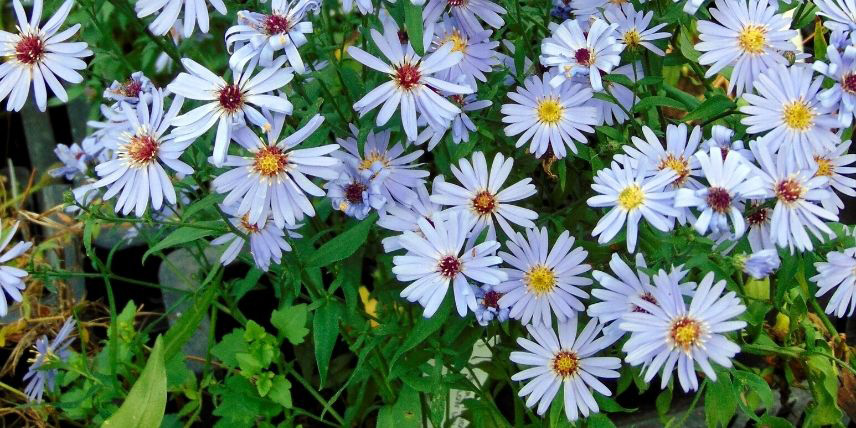
Aster cordifolius ‘Little Carlow’
→ Learn more with our complete guide on Asters
Discover other Summer flowering perennials
View all →Available in 0 sizes
Available in 1 sizes
Available in 0 sizes
Available in 0 sizes
Available in 0 sizes
Available in 0 sizes
Available in 0 sizes
Available in 0 sizes
Available in 0 sizes
Eupatoriums
Eupatoriums are large, easy-to-grow perennials that typically flower in August-September, sometimes extending into October, depending on the variety. They produce light, airy corymbs of flowers in pink, purple, or white. These flowers are melliferous, attracting butterflies and other pollinating insects.
Eupatorium thrives in rich, humus-bearing, cool to moist soil. It is an ideal plant to grow on the banks of a pond! With its wildflower appearance, it integrates beautifully into naturalistic gardens. It grows quickly and, with its upright stems, forms a stunning backdrop in borders. It is a resilient and hardy plant that primarily needs to be kept well-watered.
We particularly recommend the giant Eupatorium maculatum ‘Atropurpureum’, which can reach up to 2 m in height! There are also varieties with white flowers, such as Eupatorium ‘Bartered Bride’, and even blue ones: Eupatorium coelestinum.
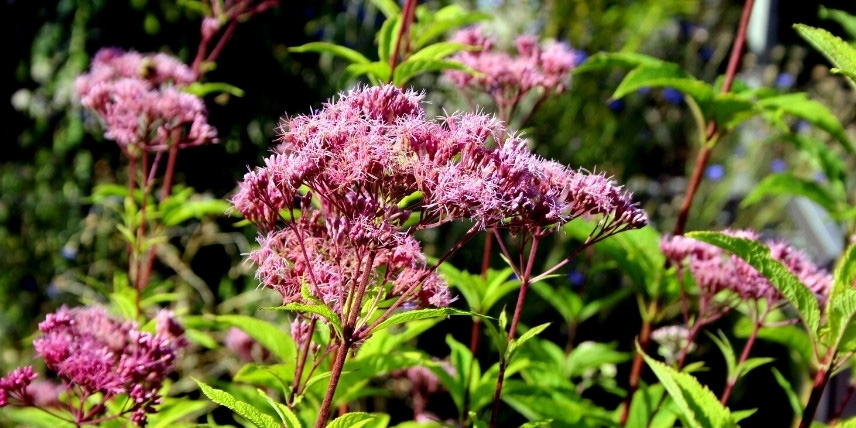
Eupatorium purpureum (photo Manuel M. V.)
Read also
6 late summer flowering shrubsSolidago
Goldenrod offers a lovely yellow flowering typically in August – September, sometimes as early as July. It is a spectacular, tall, and very bright plant, producing large feathery panicles of yellow flowers. The tallest varieties, such as Solidago altissima, can reach up to 2 m high! Others remain much shorter: Solidago ‘Spatgold’, for example, does not exceed 70 cm in height.
Goldenrod is a robust plant, well resistant to cold, as it can withstand temperatures down to –20 °C. Plant it in full sun or light shade, in any soil that remains relatively cool. We also recommend placing the taller varieties out of strong winds, which could flatten the stems.
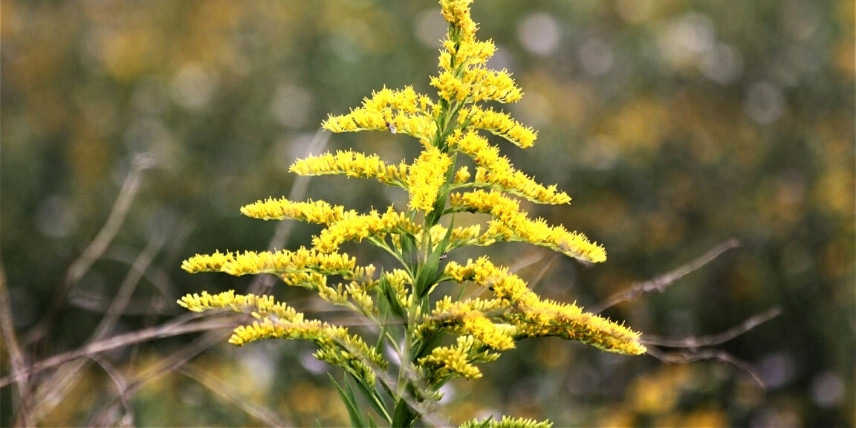
→ Learn more with our complete sheet on Goldenrod
Sedums
Sedums are succulent plants with fleshy leaves and a generally spreading, carpet-like habit. Their flowers, which take the form of small stars, produce nectar and are highly appreciated by butterflies! There are hundreds of species and varieties of sedums. For flowering in August-September, we particularly recommend Sedum ‘Sunkissed’, with cream-yellow flowers, Sedum spectabile ‘Matrona’, or Sedum ‘Autumn Joy’.
Sedums need to be planted in full sun in well-drained, rather poor, and stony soil. They are extremely drought-resistant and tolerant of temperature fluctuations. Therefore, they are perfect for creating low-maintenance dry gardens.
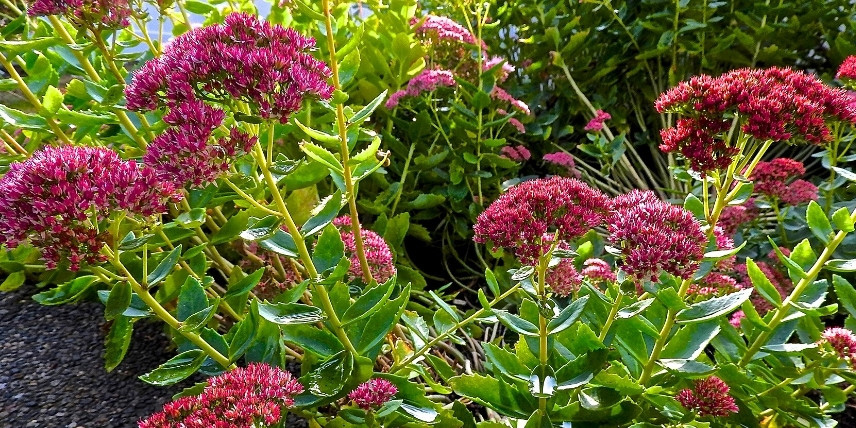
Sedum ‘Autumn Joy’ (photo Peter Stevens)
→ Learn more with our complete sheet on Sedums
Helenium
We appreciate Helenium, or Helen’s flower, for its lovely flowering in warm tones! Depending on the variety, it offers flowers with brick-red, orange, or golden-yellow petals, rounded at the centre of the head. Its flowers resemble those of daisies, but with a prominent centre and much warmer colours, heralding the glowing hues of autumn. We particularly recommend the variety ‘Potter’s Wheel’, which boasts a beautiful dark red flowering.
Plant Helenium in full sun, in fertile soil that remains relatively cool. It is easy to grow and pairs well with other perennials, such as asters, helianthus, echinaceas, or grasses. This is a hardy perennial, capable of withstanding temperatures dropping below -15 °C.
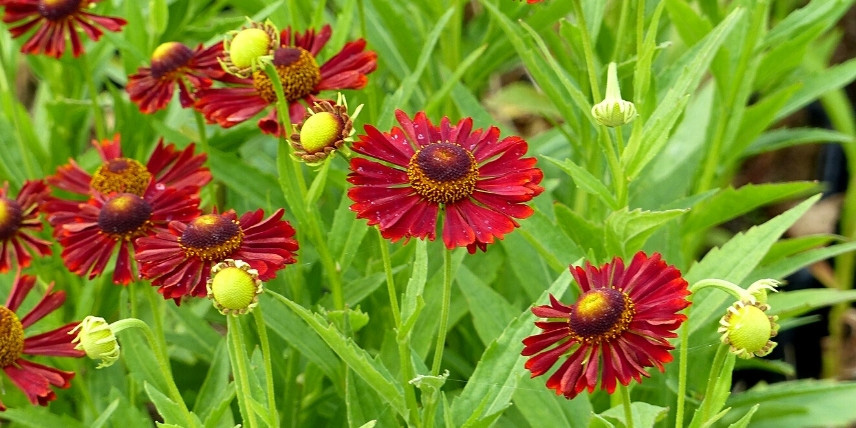
Helenium ‘Siesta’
→ Learn more with our advice sheet on Heleniums
Cimicifuga
Cimicifuga is a beautiful perennial for partial shade that produces long, slender white flower spikes, resembling tall candles. These flower spikes are composed of numerous small, highly fragrant flowers. Their elegance and graphic quality are truly appreciated! Cimicifuga also offers attractive, finely cut foliage, sometimes beautifully coloured: the variety ‘Brunette’, for example, has deep purple-brown leaves.
Cimicifuga thrives in cool, fertile soil, under dappled light or partial shade. Pair it with other woodland plants, such as hostas, Japanese anemones, ferns, carex, or hakonechloa, to create a very natural atmosphere!
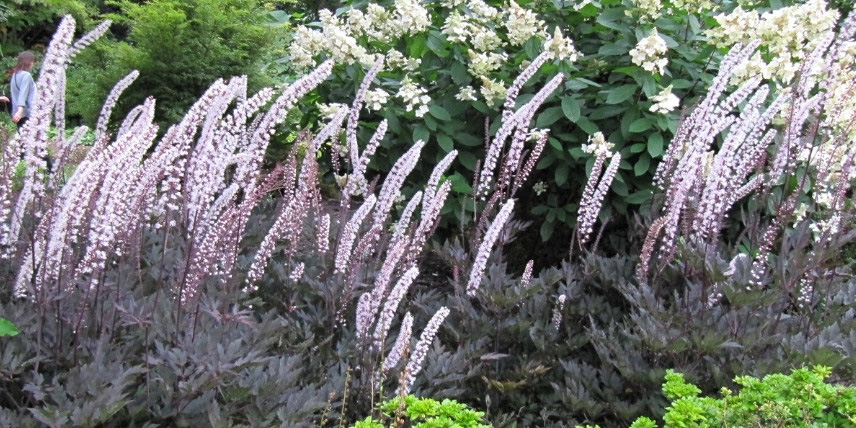
Actaea simplex ‘Brunette’ (photo Leonora Enking)
→ Learn more with our complete sheet on Cimicufagas
Echinacea
Echinacea, or Rudbeckia purpurea, is a beautiful perennial that produces flowers typically dark pink to purple, with a prominently rounded, brown-orange head at the centre. The shape of its flowers resembles that of daisies, but they are much more vibrant, and the bristly centre adds volume and graphic appeal. Echinacea is a melliferous plant, attracting bees and butterflies. We particularly recommend the varieties ‘Aloha’, with pale yellow flowers, or ‘Big Kahuna’, featuring orange blooms.
Robust and easy to grow, echinacea thrives in full sun in fertile, well-drained soil. It fits well in naturalistic gardens or in English mixed borders.
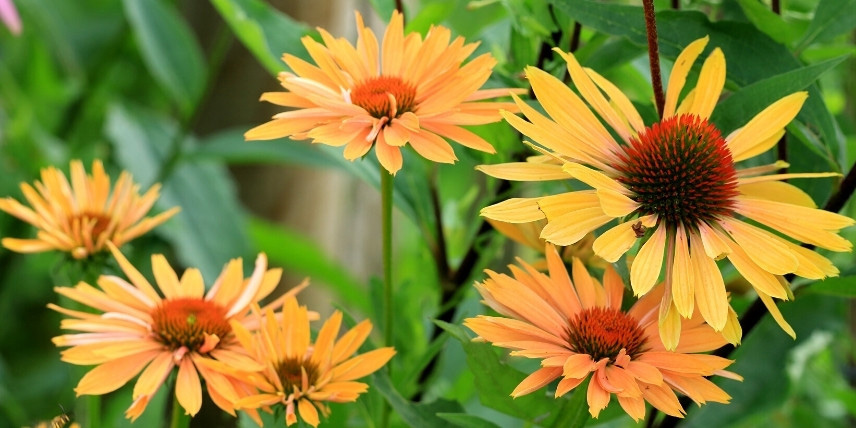
Echinacea ‘Big Kahuna’ (photo AdobeStock)
→ Learn more with our complete guide on Echinaceas
Helianthus ‘Lemon Queen’
Helianthus ‘Lemon Queen’, or perennial sunflower, produces beautiful pale yellow star-shaped flowers in heads from August to September. This large perennial can reach up to 1.5 m in height. Its flowers are perfect for creating cut flower arrangements!
Easy to grow, Helianthus ‘Lemon Queen’ thrives in full sun in any type of soil that remains relatively cool in summer. It is a versatile perennial that will find its place in most flower beds, whether in a colourful mixed border or in a cottage or naturalistic garden. It is valuable for adding a touch of brightness and lightness to the borders.
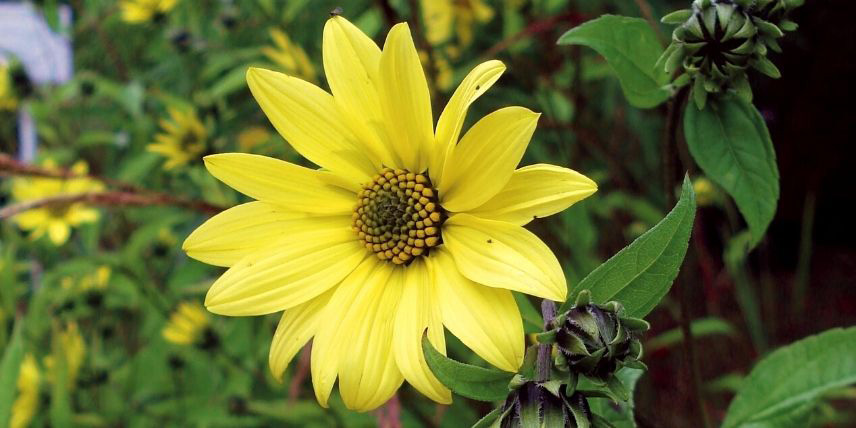
Helianthus ‘Lemon Queen’
→ Learn more with our complete sheet on Helianthus
Calamagrostis 'Brachytricha'
Calamagrostis ‘Brachytricha’, or diamond grass, is a splendid grass that produces ample, airy spikes, in a beige colour with a slight purplish hue, which later turn silver. They seem to capture sunlight and create a beautiful effect in the garden when planted in masses. These spikes are also very decorative in dried flower arrangements. Calamagrostis ‘Brachytricha’ is among the grasses that offer the most beautiful flowering.
Plant Calamagrostis ‘Brachytricha’ in ordinary soil that remains moist, in full sun in the northern half of France, and preferably in partial shade in the south.
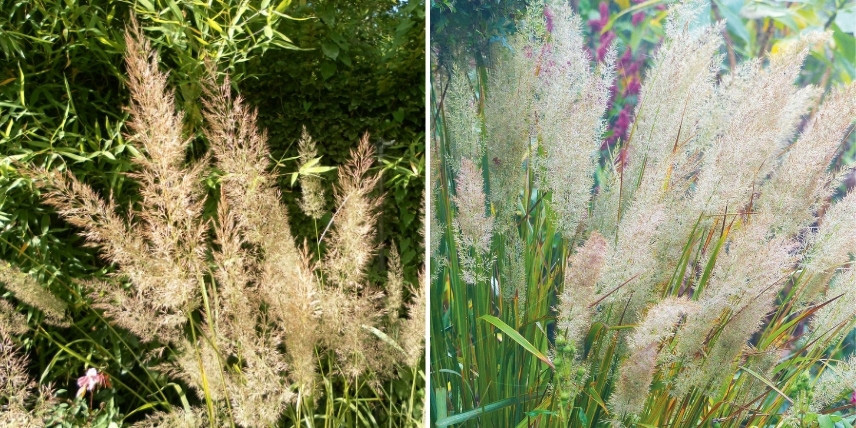
Calamagrostis brachytricha
→ Learn more with our complete sheet on Calamagrostis
- Subscribe!
- Contents
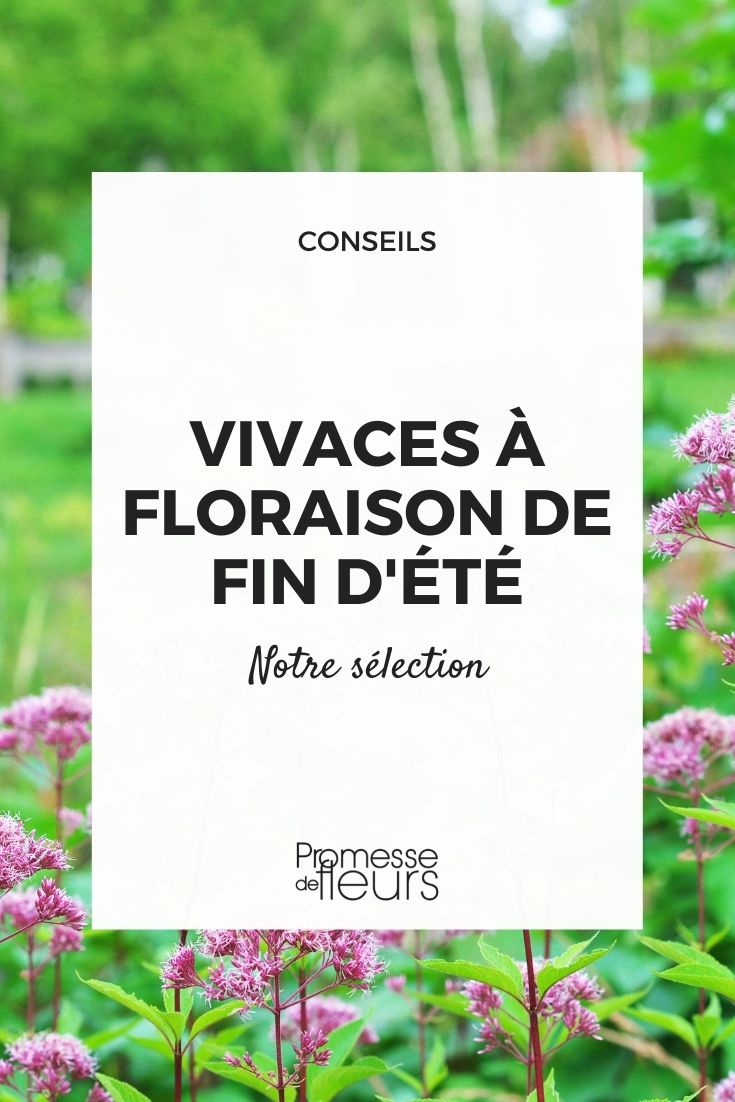































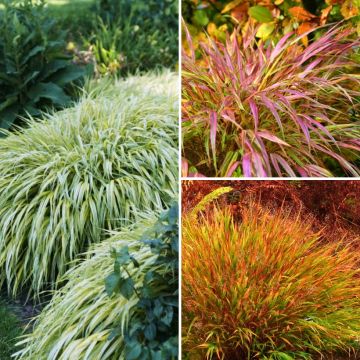
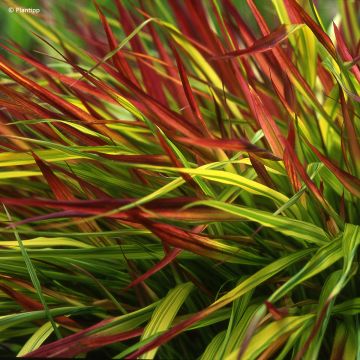
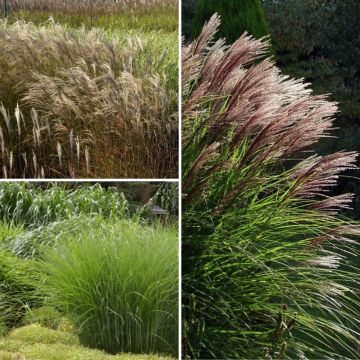
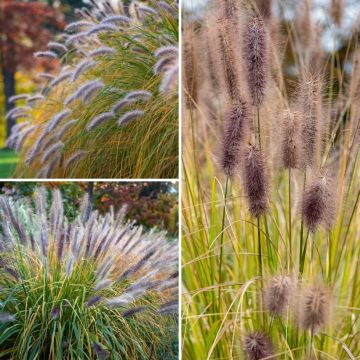
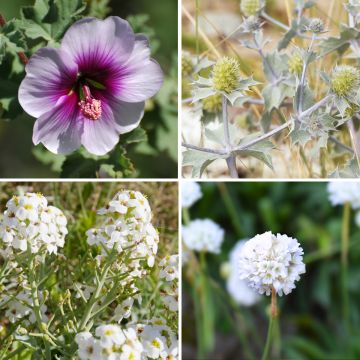
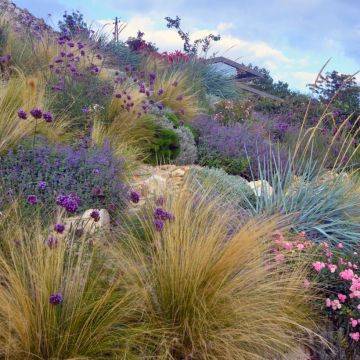
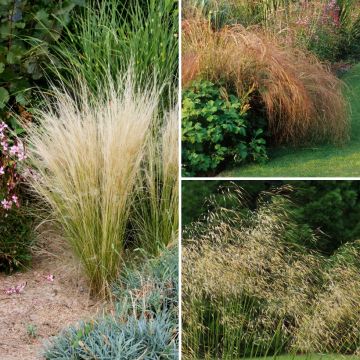
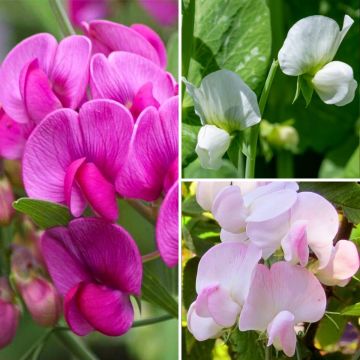
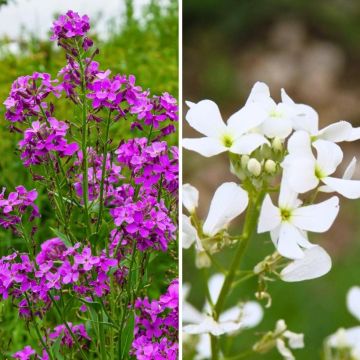
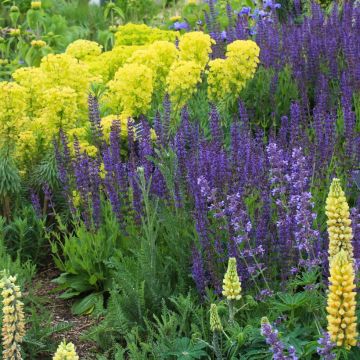
Comments